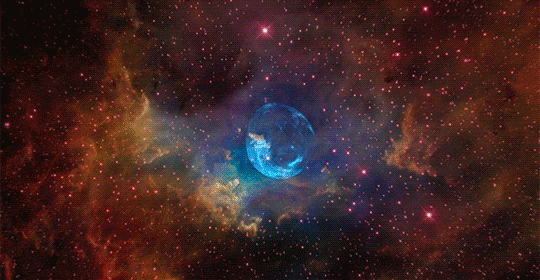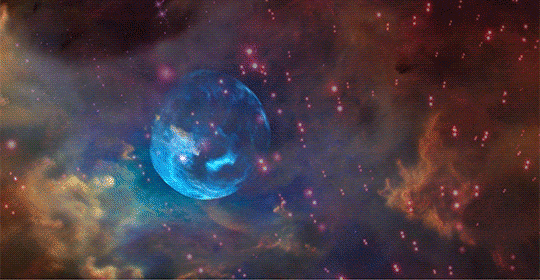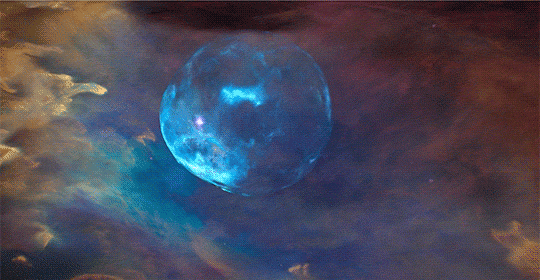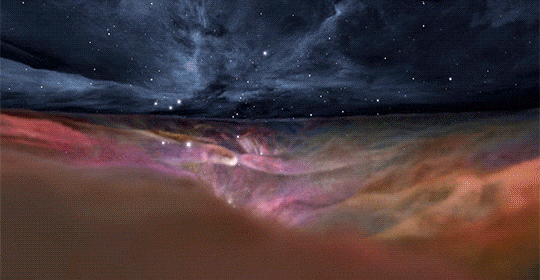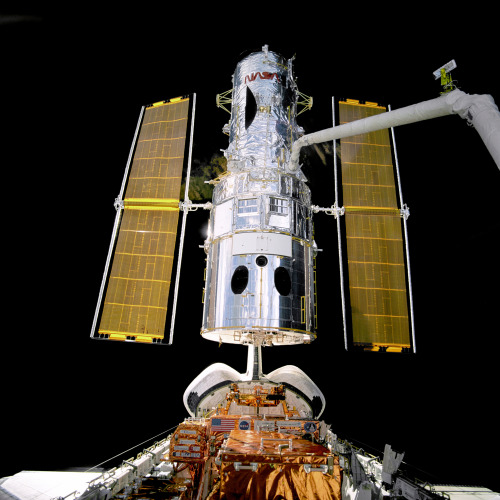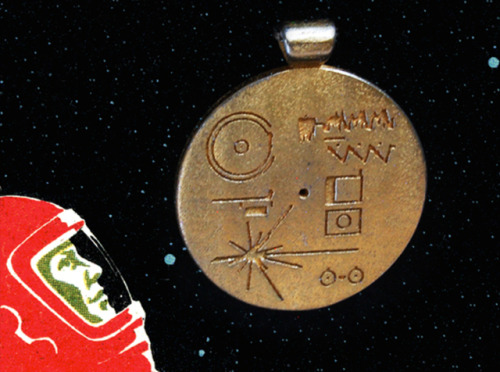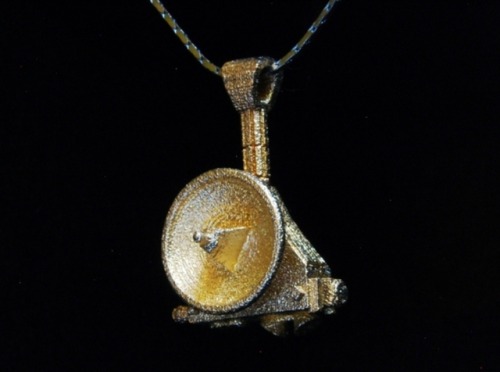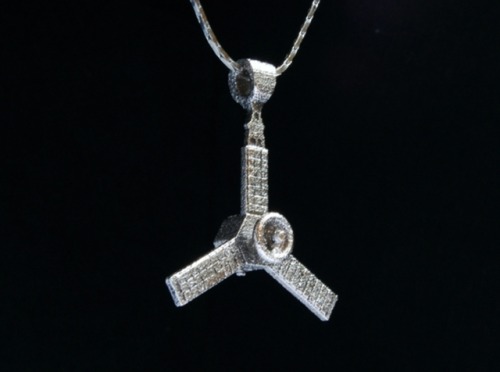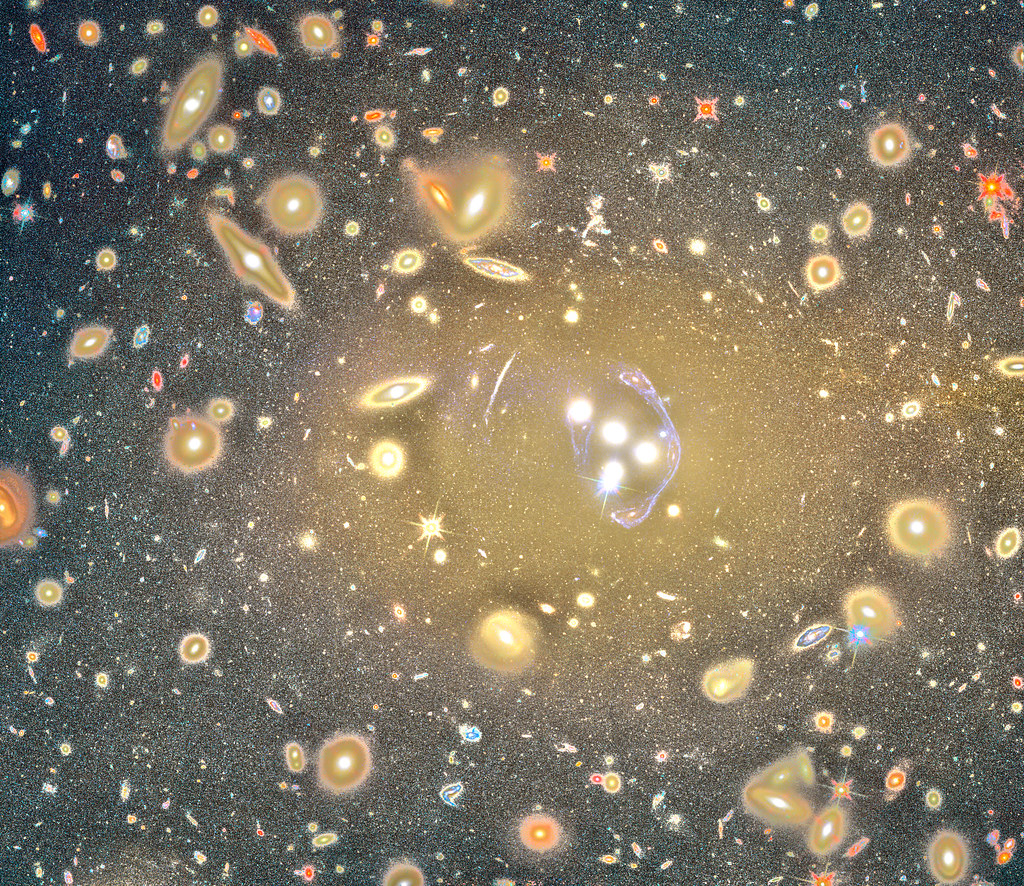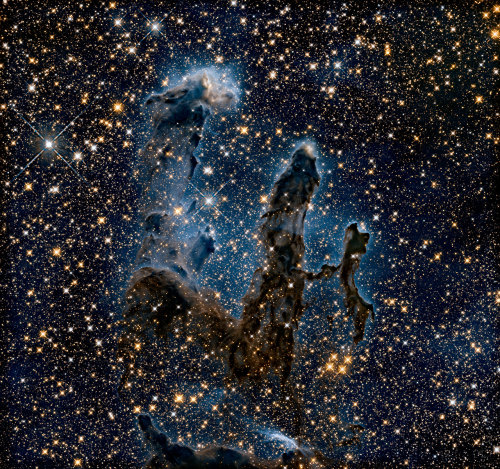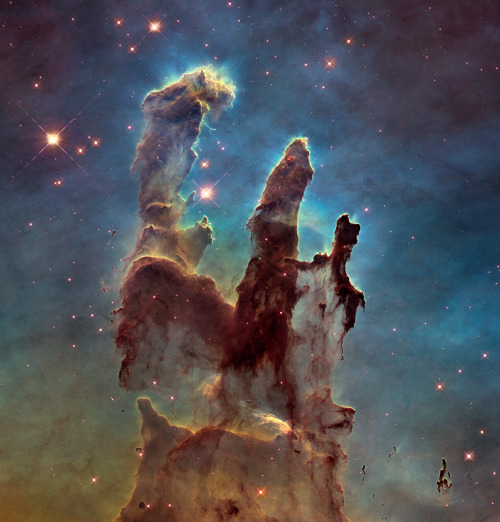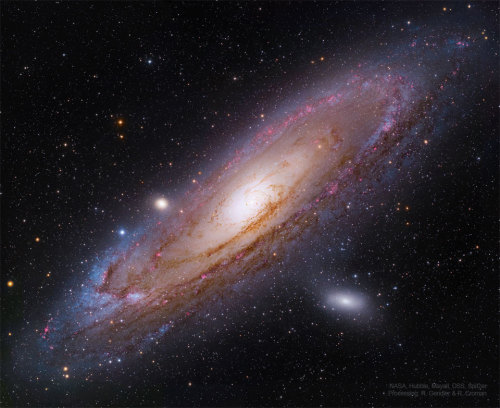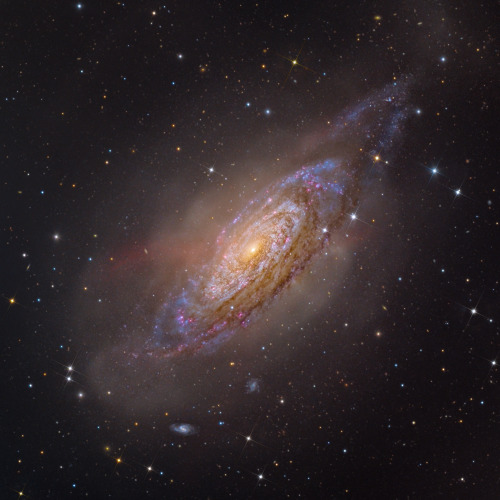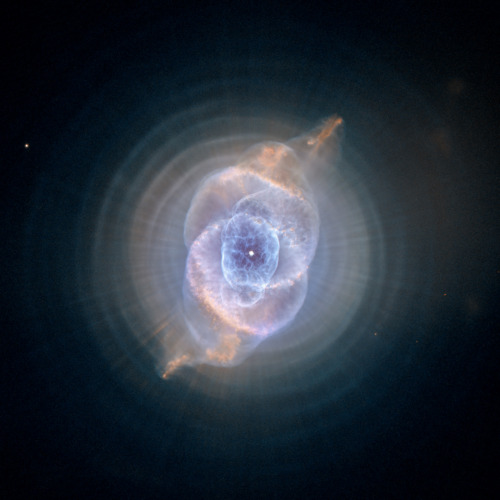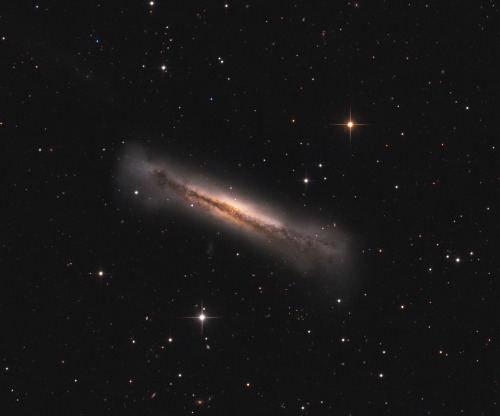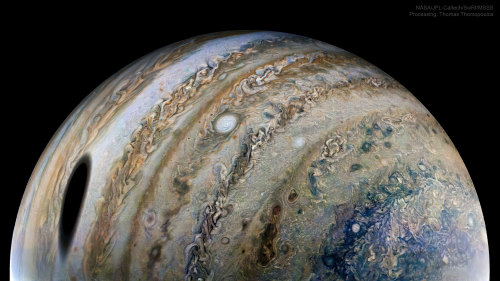#hubble space telescope
Flying Across The Universe Part 3 (From Top to Bottom: Fly through the Orion Nebula, Gum 29, and Sharpless 2-106)
Credit:HubbleSite.org
Post link

What will become of Jupiter’s Great Red Spot? Gas giant Jupiter is the solar system’s largest world with about 320 times the mass of planet Earth. Jupiter is home to one of the largest and longest lasting storm systems known, the Great Red Spot (GRS), visible to the left. The GRS is so large it could swallow Earth- but it has been shrinking. Comparison with historical notes indicate that the storm spans only about one third of the exposed surface area it had 150 years ago. NASA’s Outer Planets Atmospheres Legacy (OPAL) program has been monitoring the storm more recently using the Hubble Space Telescope. The featured Hubble OPAL image shows Jupiter as it appeared in 2016, processed in a way that makes red hues appear quite vibrant. Modern GRS data indicate that the storm continues to constrict its surface area, but is also becoming slightly taller, vertically. No one knows the future of the GRS, including the possibility that if the shrinking trend continues, the GRS might one day even do what smaller spots on Jupiter have done – disappear completely.
Image Credit: NASA, ESA, Hubble, OPAL Program, STScI; Processing: Karol Masztalerz
Attached to the “robot arm” the Hubble Space Telescope is unberthed and lifted up into the sunlight during this the second servicing mission designated HST SM-02.
Post link
It’s been way too long since our last #SpacecraftSaturday, so here are some gorgeous 3D printed designs by Matthew Loren Seeds, aka M. Loren Seeds, who’s goal is to create: “sleek and futuristic products for the home and body inspired by space, technology and physics.” Judging by these necklaces, I think he’s succeeding.
Available from his store on Shapeways:Golden Record,New Horizons,Kepler,Juno, and Hubble. You can also follow Matthew on Instagram.
-Summer
Post link
EXCITING NEWS: we sponsored the American Astronomical Society team uniforms at AAS235*! The designs feature the phases of the moon and the Hubble Space Telescope…both with POCKETS.
We are so thrilled to see them in the wild!
- Summer & Emily
*We are dividing and conquering our annual American Astronomical Society winter meeting this year with Emily in situ in Honolulu and Summer holding down the social media fort in New Mexico.
Post link
Abell 3827, variant by Stuart Rankin
Via Flickr:
EditedHubble Space Telescope image of the galaxy cluster Abell 3827. Color/processing variant. Original caption: This detailed image features Abell 3827, a galaxy cluster that offers a wealth of exciting possibilities for study. It was observed by Hubble in order to study dark matter, which is one of the greatest puzzles cosmologists face today. The science team used Hubble’s Advanced Camera for Surveys (ACS) and Wide Field Camera 3 (WFC3) to complete their observations. The two cameras have different specifications and can observe different parts of the electromagnetic spectrum, so using them both allowed the astronomers to collect more complete information. Abell 3827 has also been observed previously by Hubble, because of the interesting gravitational lens at its core. Looking at this cluster of hundreds of galaxies, it is amazing to recall that until less than 100 years ago, many astronomers believed that the Milky Way was the only galaxy in the Universe. The possibility of other galaxies had been debated previously, but the matter was not truly settled until Edwin Hubble confirmed that the Great Andromeda Nebula was in fact far too distant to be part of the Milky Way. The Great Andromeda Nebula became the Andromeda Galaxy, and astronomers recognised that our Universe was much, much bigger than humanity had imagined. We can only imagine how Edwin Hubble — after whom the Hubble Space Telescope was named — would have felt if he’d seen this spectacular image of Abell 3827.

Hubble Spots a Stunning Spiral in Ursa Major
Galaxies come in many shapes and sizes. One of the key galaxy types we see in the universe is the spiral galaxy, as demonstrated in an especially beautiful way by the subject of this Hubble Space Telescope image, NGC 2985. NGC 2985 lies over 70 million light-years from the solar system in the constellation of Ursa Major (the Great Bear).
The intricate, near-perfect symmetry on display here reveals the incredible complexity of NGC 2985. Multiple tightly wound spiral arms widen as they whirl outward from the galaxy’s bright core, slowly fading and dissipating until these majestic structures disappear into the emptiness of intergalactic space, bringing a beautiful end to their starry splendor.
Over eons, spiral galaxies tend to run into other galaxies, often resulting in mergers. These coalescing events scramble the winding structures of the original galaxies, smoothing and rounding their shape. These objects possess a beauty all their own, distinct from the spiral galaxies from whence they came.
Text credit: ESA (European Space Agency)
Image credit: ESA/Hubble & NASA, L. Ho
nasa:
Sometimes… there’s more than meets the eye. You’re looking at two very different takes on an iconic image.
Human eyes can see only a small portion of the range of radiation given off by the objects around us. We call this wide array of radiation the electromagnetic spectrum, and the part we can see visible light.In the first image, researchers revisited one of Hubble Space Telescope’s most popular sights: the Eagle Nebula’s Pillars of Creation. Here, the pillars are seen in infrared light, which pierces through obscuring dust and gas and unveil a more unfamiliar — but just as amazing — view of the pillars.
The entire frame is peppered with bright stars and baby stars are revealed being formed within the pillars themselves. The image on the bottom is the pillars in visible light.Image Credit: NASA, ESA/Hubble and the Hubble Heritage Team
Make sure to follow us on Tumblr for your regular dose of space: http://nasa.tumblr.com.
Post link
Hubble space telescope captured an image that greatly resembles Korosensei.
Assassination Classroom|animecrush
Post link

Hubble Hooks a Supernova Host Galaxy
This image from the NASA/ESA Hubble Space Telescope features the spectacular galaxy NGC 2442, nicknamed the Meathook galaxy owing to its extremely asymmetrical and irregular shape.
This galaxy was host to a supernova explosion spotted in March 2015, known as SN 2015F, that was created by a white dwarf star. The white dwarf was part of a binary star system and siphoned mass from its companion, eventually becoming too greedy and taking on more than it could handle. This unbalanced the star and triggered runaway nuclear fusion that eventually led to an intensely violent supernova explosion. The supernova shone brightly for quite some time and was easily visible from Earth through even a small telescope until months later.
Download in full resolution from ESA’s Hubble site
Text credit: ESA (European Space Agency)
Image credit: ESA/Hubble & NASA, S. Smartt et al.
Hubble Space Telescope

The Lively Center of the Lagoon Nebula
The center of the Lagoon Nebula is a whirlwind of spectacular star formation. Visible near the image center, at least two long funnel-shaped clouds, each roughly half a light-year long, have been formed by extreme stellar winds and intense energetic starlight. A tremendously bright nearby star, Hershel 36, lights the area. Vast walls of dust hide and redden other hot young stars. As energy from these stars pours into the cool dust and gas, large temperature differences in adjoining regions can be created generating shearing winds which may cause the funnels. This picture, spanning about 15 light years, features two colors detected by the orbiting Hubble Space Telescope. The Lagoon Nebula, also known as >M8, lies about 5000 light years distant toward the constellation of the Archer Sagittarius.
Image Credit: NASA, ESA, Hubble; Processing & Copyright: Diego Gravinese
Time And Space

The Ion Tail of New Comet SWAN
Newly discovered Comet SWAN has already developed an impressive tail. The comet came in from the outer Solar System and has just passed inside the orbit of the Earth. Officially designated C/2020 F8 (SWAN), this outgassing interplanetary iceberg will pass its closest to the Earth on May 13, and closest to the Sun on May 27. The comet was first noticed in late March by an astronomy enthusiast looking through images taken by NASA’s Sun-orbiting SOHO spacecraft, and is named for this spacecraft's Solar Wind Anisotropies (SWAN) camera. The featured image, taken from the dark skies in Namibia in mid-April, captured Comet SWAN's green-glowing coma and unexpectedly long, detailed, and blue ion-tail. Although the brightness of comets are notoriously hard to predict, some models have Comet SWAN becoming bright enough to see with the unaided eye during June.
Image Credit & Copyright: Gerald Rhemann
SOHO
Time And Space

Eagle Nebula’s Pillars of Creation in Infrared
Human eyes can see only a small portion of the range of radiation given off by the objects around us. We call this wide array of radiation the electromagnetic spectrum, and the part we can see visible light.
In this Hubble Space Telescope image, researchers revisited one of Hubble's most iconic and popular images: the Eagle Nebula’s Pillars of Creation.
Here, the pillars are seen in infrared light, which pierces through obscuring dust and gas and unveil a more unfamiliar - but just as amazing - view of the pillars. The better-known image is of the pillars in visible light.
In this ethereal view the entire frame is peppered with bright stars and baby stars are revealed being formed within the pillars themselves. The ghostly outlines of the pillars seem much more delicate, and are silhouetted against an eerie blue haze.
Explore how light affects the images we see. Find more online activities on Hubble Inspires.
Image Credit: NASA, ESA/Hubble and the Hubble Heritage Team
Hubble Space Telescope
Time And Space

Hubble Captures a Cannibal Galaxy
This remarkable spiral galaxy, known as NGC 4651, may look serene and peaceful as it swirls in the vast, silent emptiness of space, but don’t be fooled - it keeps a violent secret. It is believed that this galaxy consumed another smaller galaxy to become the large and beautiful spiral that we observe today.
Although only a telescope like the NASA/ESA Hubble Space Telescope, which captured this image, could give us a picture this clear, NGC 4651 can also be observed with an amateur telescope - so if you have a telescope at home and a star-gazing eye, look out for this glittering carnivorous spiral.
Text credit: ESA (European Space Agency)
Image credit: ESA/Hubble & NASA, D. Leonard
Hubble Space Telescope
Time And Space

M77: Spiral Galaxy with an Active Center
What’s happening in the center of nearby spiral galaxy M77? The face-on galaxy lies a mere 47 million light-years away toward the constellation of the Sea Monster (Cetus). At that estimated distance, this gorgeous island universe is about 100 thousand light-years across. Also known as NGC 1068, its compact and very bright core is well studied by astronomers exploring the mysteries of supermassive black holes in active Seyfert galaxies. M77 and its active core glows bright at x-ray, ultraviolet, visible, infrared, and radio wavelengths. The featured sharp image of M77 was taken by the Hubble Space Telescope and is dominated by the (visible) red light emitted by hydrogen. The image shows details of the spiral's winding spiral arms as traced by obscuring dust clouds, and red-tinted star forming regions close in to the galaxy’s luminous core.
Image Copyright: Image Credit: Hubble, NASA, ESA; Processing & License: Judy Schmidt
Hubble Space Telescope
Time And Space

UGC 12591: The Fastest Rotating Galaxy Known
Why does this galaxy spin so fast? To start, even identifying which type of galaxy UGC 12591 is difficult – featured on the lower left, it has dark dust lanes like a spiral galaxy but a large diffuse bulge of stars like a lenticular. Surprisingly observations show that UGC 12591 spins at about 480 km/sec, almost twice as fast as our Milky Way, and the fastest rotation rate yet measured. The mass needed to hold together a galaxy spinning this fast is several times the mass of our Milky Way Galaxy. Progenitor scenarios for UGC 12591 include slow growth by accreting ambient matter, or rapid growth through a recent galaxy collision or collisions – future observations may tell. The light we see today from UGC 12591 left about 400 million years ago, when trees were first developing on Earth.
Image Credit: NASA, ESA, Hubble; Processing & Copyright: Leo Shatz
Time And Space

Star Formation in the Tadpole Nebula
What’s all of the commotion in the Tadpole Nebula? Star formation. Dusty emission in the Tadpole Nebula, IC 410, lies about 12,000 light-years away in the northern constellation of the Charioteer (Auriga). The cloud of glowing gas is over 100 light-years across, sculpted by stellar winds and radiation from embedded open star cluster NGC 1893. Formed in the interstellar cloud a mere 4 million years ago, bright newly formed cluster stars are seen all around the star-forming nebula. Notable near the image center are two relatively dense streamers of material trailing away from the nebula’s central regions. Potentially sites of ongoing star formation in IC 410, these cosmic tadpole shapes are about 10 light-years long. The featured image was taken in infrared light by NASA’s Wide Field Infrared Survey Explorer (WISE) satellite.
Image Credit: WISE, IRSA, NASA; Processing & Copyright: Francesco Antonucci
Time And Space
The Once and Future Stars of Andromeda (NASA Astronomy Picture of the Day of May 23 of 2022)
Post link

